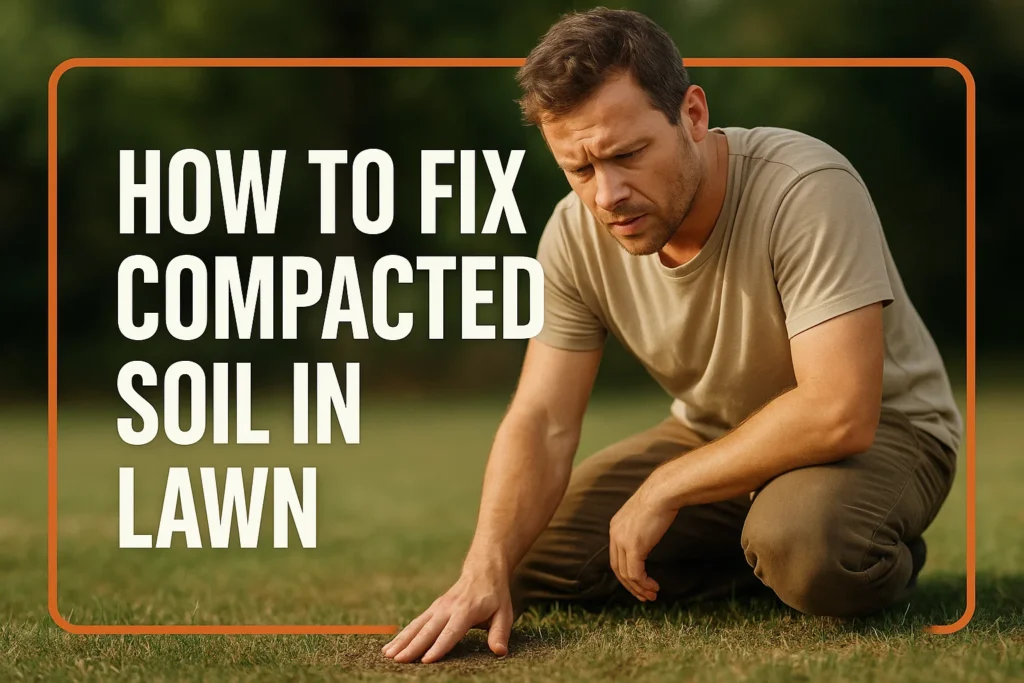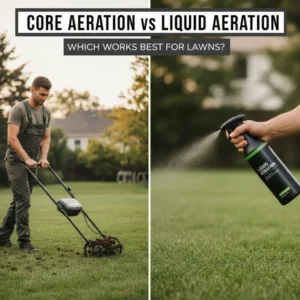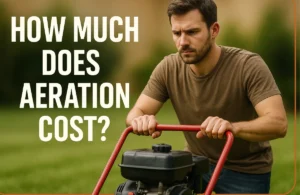The basics of proper lawn care begin with knowing what kind of soil and grass you have and what they need. Most lawns suffer from soil compaction, where the limited space between soil particles prevents water and nutrients from reaching the roots. The techniques to correct compacted soil allow more air to enter and restore vital nutrients, encouraging your lawn to thrive. This easy guide tells you how elevating your lawn’s soil condition can give you a green and flourishing yard. Both beginners and experts can build a solid base for a better lawn.
What Causes Soil Compaction in a Lawn
Soil compaction refers to the phenomenon in which soil particles are squeezed together, leaving little room for air, water, and nutrients. It restricts the roots and allows grass to escape. Soil compaction may be common due to the following reasons.
How can I tell if my lawn is compacted?
Recognizing soil compaction early gives you the chance to correct it before it starts causing permanent damage to your lawn. Numerous signs indicate compacted soil:
Hard, Crusty Soil Surface
Compacted soil often feels firm and robust underfoot. Following rain or irrigation, the top layer might develop a solid shell that won’t budge when you squeeze it. Without enough area between the soil particles, the water doesn’t soak in, and the roots can’t bind in.
Poor drainage and water accumulation: If you notice standing water in places and the water rolling back rather than soaking in, the soil is likely to be compressed.
Poor Drainage and Water Pooling
Slick locations will emerge since compacted soil blocks water infiltration, whereas runoff will become more significant, dragging the soil and nutrients away.
Thin or Patchy Grass
Thinning grass and patchy grass, because compressed soil confines root development, your grass will suffer and may be scrawny or dotted. Water and nutrients won’t be able to reach, causing these areas to struggle.
Shallow roots
Healthy grass has long, slender roots extending down to get moisture and nutrition. In compressed soil, the roots become flatter or even spread out more, making the lawn more vulnerable to drought and pressure.
Presence Of Weeds
Some weeds, such as knotweed or crabgrass, thrive in this area of the grass. There is an increase in the amount of grass.
Difficulties in digging the soil or a lack of access
The soil pressure is so powerful that you’re struggling to push a garden fork or a screwdriver into the ground. The lack beneath the soil is evident as a result.
Surface cracking
Dry, compacted soil can shrink and split, causing the surface to crack. They exacerbate water run-off while also degrading the rooting surfaces.
Will Grass Grow on Hard-Packed Dirt?
Can grass grow on hard-packed dirt? Difficult but possible. Hard soil lacks the basic structural elements (air, water, and nutrients) for the roots to grow. Seeds sometimes struggle to germinate, and the roots rarely penetrate the top layer, leading to weak and patchy growth. Hard-packed dirt is usually both dry and packed and is comparable to a hard crust.
However, you may improve it by wetting the soil to make it softer, opening the topsoil with aeration or tilling, and adding organic matter like compost to make it more palatable for the grass to colonize it. Soil preparation combined with consistent watering generally improves the growth of grass on hard-packed dirt. Simply tossing seeds on hard, untreated soil is always unlikely to yield excellent results.
How to Fix Compacted Soil in Your Lawn
Fixing compacted soil is essential to reviving a healthy lawn. Compacted soil prevents water, air, and nutrients from reaching grass roots, leading to minimal growth. The following steps may be used to rejuvenate the soil.
Aerate the Lawn
Aeration creates holes in the soil to improve air and water circulation. A garden fork or hand aerator can be used to poke holes in smaller areas to a depth of around 3 to 4 inches. To poke small cores of soil out of larger lawns, try shoe soles. This breaks down compacted layers and promotes root growth.
Topdress Organic Material
After aeration, apply a thin top-dressing of compost or high-quality topsoil to the lawn. It breaks down healing properties and improves soil texture while also providing microbial growth with nutrients. Spray or water gently to settle the top dressing in the hole.
Water deeply and correctly
Deep watering aids roots growing downward and heals loose soil. Slow down the watering process to keep moisture from running off or forming pools. Avoid irrigation and pool management.
Adapt to the weather
Avoid walking or using heavy machinery on wet soil, which exacerbates subsidence, reduce mowing, and promote grasses with better root systems. Control the soak and irrigation method to avoid excessive watering.
Consider Liquid Aeration
Liquid aerators, admittedly, differ from mechanical ones by their similarity to nature. They’re more efficient than mechanical aeration and need more day-to-day maintenance. Regular services combining the mixture can reverse compaction, improve lawn fitness, and restore a matt, green yard.
Conclusion
Reviving hard-packed soil is crucial for maintaining a healthy, vibrant lawn. This guide has provided an overview of the causes of soil compaction and how to recognize the symptoms. Additionally, it highlighted ways to address the issue, such as aeration, organic matter, and sound lawn care practices that will loosen the hard-packed soil and nurture robust grass growth. If grass cannot grow effectively, homeowners’ other options include ground covers, mulch, and artificial or other items to improve their outdoor living space.
At Revamping Lawn, we specialize in restoring lawns by aerating and topdressing, and provide more tailored lawn care solutions. Contact us to get a year-round, radiant green rug in your backyard.
FAQ’s
Common causes include walking, driving, working on wet soil and clay-heavy soils.
It’s hard to touch; the water doesn’t drain well, the grass is unevenly distributed, the roots can’t grow deep, and you can’t dig a hole with it.
Grass roots do not penetrate the ground well without these steps to loosen the soil and make conditions right.
Aerating, top dressing with compost, and sound watering habits are the most effective.
How do I soften the soil for grass seeds?



